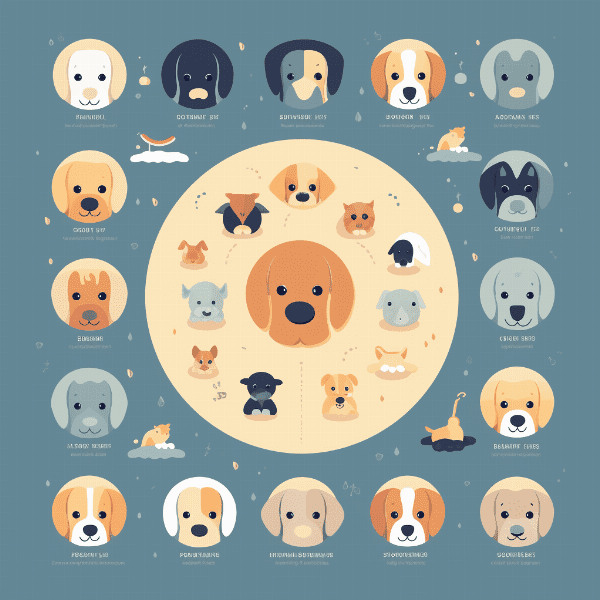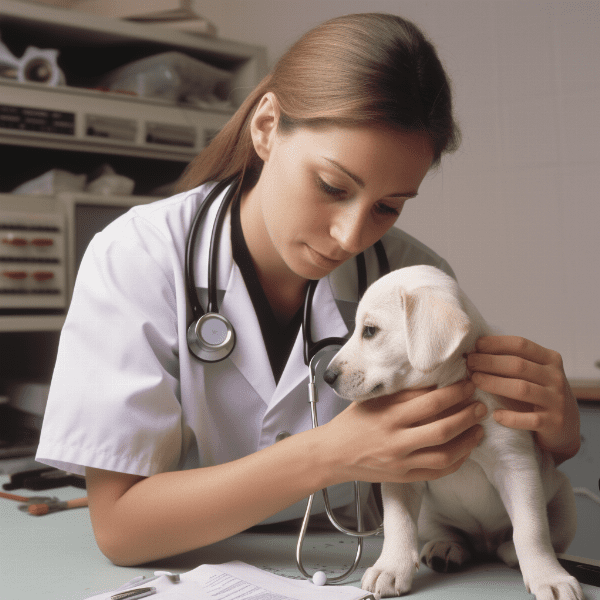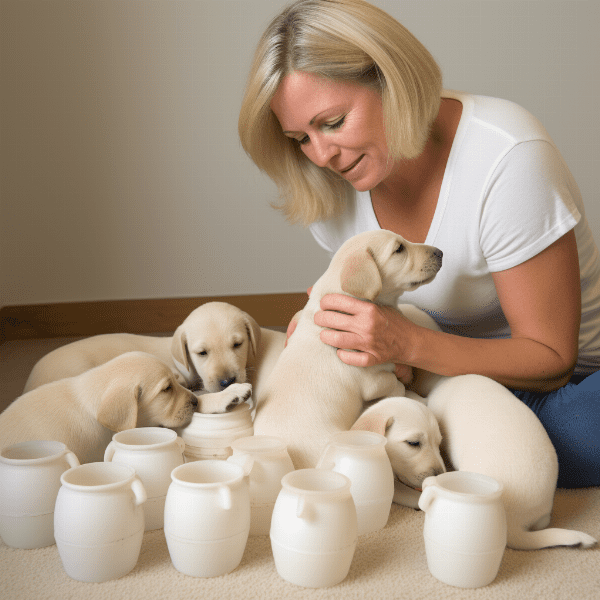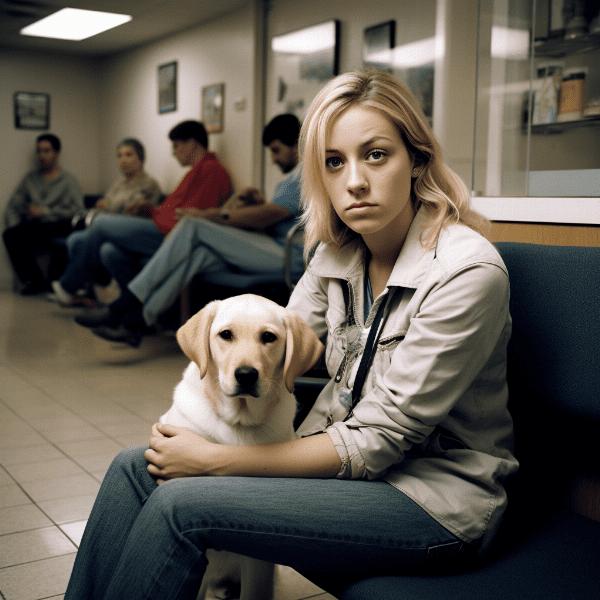Table of Contents
- Understanding Newborn Puppy Crying
- Reasons Why Newborn Puppies Cry
- Assessing Your Newborn Puppy’s Health
- Tips to Comfort a Crying Newborn Puppy
- Feeding Newborn Puppies and Managing Crying
- Creating a Calm Environment for Your Newborn Puppy
- When to Seek Veterinary Assistance
- Training Your Newborn Puppy to Reduce Crying
- Socializing Newborn Puppies to Reduce Crying
- Final Thoughts on Helping Your Newborn Puppy Stop Crying
Understanding Newborn Puppy Crying
Crying is a natural behavior for newborn puppies. They use crying to communicate their needs and desires to their mother. However, when puppies are separated from their mother or are orphaned, they will cry for extended periods. Understanding the reasons for a Newborn puppy crying is critical to addressing their needs and promoting their well-being.
The Nature of Newborn Puppies
Newborn puppies are entirely dependent on their mother for their needs. They are born blind, deaf, and unable to regulate their body temperature. As such, they rely on their mother to provide them with warmth, milk, and cleanliness. Their crying can be their way of calling their mother for these essential needs.
Developmental Stages of Newborn Puppies
Newborn puppies go through critical developmental stages, including the neonatal period, transitional period, and socialization period. During the neonatal period (0-2 weeks), puppies are almost entirely dependent on their mother for survival, and crying is their primary means of communicating. During the transitional period (2-4 weeks), puppies begin to open their eyes and ears, start to walk, and interact with their littermates. During the socialization period (4-12 weeks), puppies develop their personalities, learn social cues, and explore their environment. Understanding which period the puppy is in can help identify the cause of their crying.
Signs of Distress in Newborn Puppies
While crying is a natural behavior for newborn puppies, excessive crying or crying accompanied by other signs of distress can indicate an underlying issue. Signs of distress may include trembling, restlessness, lethargy, vomiting, diarrhea, or lack of appetite. It is essential to pay attention to these signs and seek veterinary assistance if necessary.
In conclusion, understanding the nature of newborn puppies, their developmental stages, and signs of distress is critical to addressing their crying needs. By identifying the underlying cause of their crying, we can promote their well-being and ensure their healthy development.

Reasons Why Newborn Puppies Cry
Newborn puppies may cry for a variety of reasons. Identifying the cause of their crying is essential to addressing their needs and promoting their well-being. In this section, we’ll explore some common reasons why newborn puppies cry.
Hunger and Thirst
One of the most common reasons for a newborn Puppy crying is hunger or thirst. Newborn puppies require frequent feedings, usually every 2-3 hours, to meet their nutritional needs. If a puppy is crying, it may be a sign that they are hungry or thirsty.
Need for Elimination
Newborn puppies cannot control their bladder or bowel movements and rely on their mother to stimulate these functions. If a puppy is crying, it may be a sign that they need to eliminate. If the puppy is orphaned or separated from their mother, they will require assistance to eliminate.
Discomfort or Pain
Newborn puppies may cry if they are uncomfortable or in pain. They may have a full bladder or bowel, be too cold or too hot, or have a skin irritation or injury. If a puppy is crying excessively or accompanied by other signs of distress, it may be a sign that they are uncomfortable or in pain.
Separation Anxiety
Newborn puppies are naturally social creatures and feel most secure with their mother and littermates. If a puppy is separated from their mother or littermates, they may cry due to separation anxiety.
Environmental Factors
Newborn puppies are sensitive to their environment and may cry if they are in an uncomfortable or unfamiliar environment. Loud noises, bright lights, and strong odors can be overwhelming for a newborn puppy.
In conclusion, newborn puppies may cry for a variety of reasons, including hunger, thirst, need for elimination, discomfort or pain, separation anxiety, or environmental factors. Identifying the cause of the puppy’s crying is crucial to addressing their needs and promoting their well-being.

Assessing Your Newborn Puppy’s Health
Assessing your newborn puppy’s health is critical to identifying any underlying issues that may be causing their crying. In this section, we’ll explore some essential steps to assess your puppy’s health.
Physical Examination
Performing a physical examination of your puppy can help identify any signs of distress or abnormalities. Look for any signs of discomfort or pain, such as limping or reluctance to move. Check for any discharge from the eyes or nose, skin irritations, or injuries. Observe your puppy’s breathing and listen for any unusual sounds.
Temperature Check
Newborn puppies cannot regulate their body temperature, and it is essential to monitor their temperature regularly. Use a rectal thermometer to check your puppy’s temperature. The normal temperature for a newborn puppy is around 96-97°F.
Weight Check
Weigh your puppy regularly to monitor their growth and development. A healthy newborn puppy should gain weight every day. A sudden loss of weight or failure to gain weight may be a sign of an underlying issue.
Feeding Habits
Monitor your puppy’s feeding habits, including the amount of milk they are consuming, their appetite, and their ability to suckle. If your puppy is orphaned or separated from their mother, you may need to assist with feeding.
Elimination Habits
Observe your puppy’s elimination habits, including the frequency and consistency of their bowel movements and urine output. Newborn puppies require assistance with elimination and may need stimulation after feedings.
In conclusion, assessing your newborn puppy’s health is critical to identifying any underlying issues that may be causing their crying. Performing a physical examination, checking their temperature and weight, monitoring their feeding and elimination habits can help identify any signs of distress or abnormalities. Seeking veterinary assistance if necessary can promote the puppy’s well-being and healthy development.

Tips to Comfort a Crying Newborn Puppy
Comforting a crying newborn puppy requires patience, attention, and understanding. In this section, we’ll explore some essential tips to help comfort a crying newborn puppy.
Provide Warmth
Newborn puppies cannot regulate their body temperature, and it is crucial to keep them warm. Use a heating pad or heat lamp to provide a warm and cozy environment. Ensure that the puppy has a comfortable and safe sleeping area.
Feeding and Hydration
Newborn puppies require frequent feedings to meet their nutritional needs. Ensure that the puppy is getting enough milk, either from their mother or a milk replacer if they are orphaned or separated from their mother. Monitor the puppy’s hydration by observing their urine output and ensuring they have access to fresh water.
Gentle Stimulation
Newborn puppies require assistance with elimination and may need gentle stimulation after feedings. Use a warm and damp washcloth to stimulate the puppy’s genital area to help them eliminate.
Calming Environment
Creating a calm environment can help comfort a crying newborn puppy. Keep the environment quiet and free of loud noises or sudden movements. Use a soft and gentle voice to soothe the puppy.
Seek Veterinary Assistance
If a newborn puppy’s crying is excessive or accompanied by other signs of distress, it may be a sign of an underlying issue. Seek veterinary assistance to ensure the puppy’s well-being.
In conclusion, comforting a crying newborn puppy requires providing warmth, proper feeding and hydration, gentle stimulation, a calming environment, socialization, and seeking veterinary assistance if necessary. By understanding the puppy’s needs and providing them with the necessary care and attention, we can promote their well-being and healthy development.

Feeding Newborn Puppies and Managing Crying
Feeding newborn puppies is crucial to their growth and development. In this section, we’ll explore some essential tips for feeding and managing the crying of newborn puppies.
Milk Replacer
Newborn puppies require frequent feedings of milk to meet their nutritional needs. If the puppy is orphaned or separated from their mother, a milk replacer formulated for puppies can be used. Follow the instructions on the package for mixing and serving.
Feeding Schedule
Newborn puppies should be fed every 2-3 hours, including throughout the night. Stick to a regular feeding schedule to help the puppy develop a routine. Use a syringe, bottle, or dropper to feed the puppy, depending on their size and age.
Burping
After feeding, it’s important to burp the puppy to release any air trapped in their stomach. Hold the puppy against your chest and gently pat their back.
Managing Crying
Newborn puppies may cry after feeding, but excessive crying may indicate an issue. Ensure that the puppy is getting enough milk, is warm and comfortable, and has been properly stimulated for elimination. A crying puppy may need to be held and comforted or may need a change of environment.
Weaning
Around 3-4 weeks of age, puppies can begin to be introduced to solid food. Start with a small amount of softened puppy food mixed with milk replacer and gradually increase the amount. Weaning should be a gradual process, with puppies still receiving milk replacer until they are fully transitioned to solid food.
Water
Newborn puppies do not require water as they receive hydration from their mother’s milk. However, if the puppy is orphaned or separated from their mother, they will require access to fresh water.
In conclusion, feeding newborn puppies requires a milk replacer, a regular feeding schedule, burping, and weaning to solid food gradually. Managing crying involves ensuring the puppy’s needs are met, providing comfort, and seeking veterinary assistance if necessary. By providing proper nutrition and care, we can promote the puppy’s healthy development.

Creating a Calm Environment for Your Newborn Puppy
Creating a calm environment for your newborn puppy is essential to their well-being and healthy development. In this section, we’ll explore some essential tips for creating a calm environment for your puppy.
Quiet and Comfortable Sleeping Area
Newborn puppies require a comfortable and safe sleeping area. Ensure that the area is quiet, free of loud noises or sudden movements, and provides adequate warmth. Use a soft and cozy bedding material.
Temperature Control
Newborn puppies cannot regulate their body temperature and require a warm and consistent environment. Use a heating pad or heat lamp to provide a warm and comfortable temperature. Ensure that the puppy is not too hot or too cold by monitoring their body temperature.
Gentle Handling
Newborn puppies are fragile and require gentle handling. Use a soft touch when handling the puppy and support their head and body. Avoid sudden movements or rough handling.
Newborn puppies benefit from socialization with their littermates and humans. Spend time with the puppy, holding them and petting them gently. Introduce them to new sights and sounds in a safe and controlled manner.
Calming Sounds and Scents
Calming sounds and scents can help create a relaxing environment for your puppy. Soft music, white noise, or the sound of a heartbeat can provide a sense of security for the puppy. Lavender or chamomile scents can also have a calming effect.
Managing Visitors
Newborn puppies are sensitive to their environment and may become overwhelmed by too many visitors. Limit the number of visitors and ensure that they are calm and gentle with the puppy. Encourage visitors to wash their hands before handling the puppy.
In conclusion, creating a calm environment for your newborn puppy requires providing a quiet and comfortable sleeping area, temperature control, gentle handling, socialization, calming sounds and scents, and managing visitors. By creating a safe and comfortable environment, we can promote the puppy’s well-being and healthy development.

When to Seek Veterinary Assistance
While crying is a natural behavior for newborn puppies, excessive crying or crying accompanied by other signs of distress can indicate an underlying issue. In this section, we’ll explore some essential signs that may indicate the need for veterinary assistance.
Signs of Distress
If a newborn puppy is crying excessively or accompanied by other signs of distress, such as restlessness, lethargy, vomiting, diarrhea, or lack of appetite, it may be a sign of an underlying issue. These signs can indicate a range of issues, from digestive problems to infection or injury.
Failure to Thrive
If a newborn puppy is not gaining weight or losing weight, it may be a sign of an underlying issue. Puppies should gain weight every day, and a sudden loss of weight can be a sign of an underlying illness.
Failure to Eliminate
Newborn puppies require assistance with elimination and may need stimulation after feedings. If a puppy is not eliminating or is having difficulty eliminating, it may be a sign of an underlying issue.
Respiratory Distress
Newborn puppies are vulnerable to respiratory issues, and any signs of difficulty breathing or abnormal breathing sounds should be taken seriously. If a puppy is struggling to breathe, seek veterinary assistance immediately.
Abnormal Behaviors
If a newborn puppy is displaying abnormal behaviors, such as excessive lethargy or hyperactivity, it may be a sign of an underlying issue. Any sudden changes in behavior should be monitored closely and evaluated by a veterinarian if necessary.
In conclusion, it is essential to monitor newborn puppies closely for any signs of distress, failure to thrive or eliminate, respiratory distress, or abnormal behaviors. If any of these signs are present, seek veterinary assistance immediately to ensure the puppy’s well-being and healthy development.

Training Your Newborn Puppy to Reduce Crying
Training your newborn puppy to reduce crying can be a challenging but essential task. In this section, we’ll explore some essential tips for training your puppy to reduce crying.
Routine
Establishing a routine for your puppy can help reduce their anxiety and promote calm behavior. Stick to a regular feeding and sleeping schedule, and incorporate playtime and socialization into their routine.
Crate Training
Crate training can provide a safe and comfortable space for your puppy and reduce their anxiety. Start by introducing the crate as a positive and rewarding space, using treats and praise. Gradually increase the amount of time your puppy spends in the crate, always ensuring they have access to water and toys.
Socialization is essential for reducing anxiety and promoting calm behavior. Introduce your puppy to new people, places, and experiences in a safe and controlled manner. Encourage positive interactions with other dogs and animals.
Exercise and Play
Regular exercise and playtime can help reduce anxiety and promote calm behavior in your puppy. Incorporate activities such as walking, running, and playing fetch into your puppy’s routine.
Avoid Punishment
Punishing your puppy for crying can be counterproductive and increase their anxiety. Instead, focus on positive reinforcement and redirecting their behavior. Provide comfort and attention when your puppy is calm and quiet.
In conclusion, training your newborn puppy to reduce crying requires positive reinforcement, establishing a routine, crate training, socialization, exercise and play, and avoiding punishment. By providing your puppy with a safe and comfortable environment and reinforcing positive behaviors, we can promote their well-being and healthy development.

Socializing Newborn Puppies to Reduce Crying
Socialization is a critical aspect of reducing crying and promoting calm behavior in newborn puppies. In this section, we’ll explore some essential tips for socializing your puppy.
Early Socialization
Early socialization is crucial for promoting calm behavior in your puppy. Introduce your puppy to new experiences, people, and animals as early as possible. This will help them become accustomed to new sights, sounds, and smells and reduce their anxiety.
Positive Reinforcement
Positive reinforcement is a powerful tool for socializing your puppy. When your puppy displays calm and appropriate behavior, reward them with treats, praise, or affection. This will help reinforce positive behaviors and encourage your puppy to continue exhibiting them.
Controlled Socialization
Socialization should be done in a safe and controlled manner. Introduce your puppy to new experiences and people gradually and in a positive manner. Ensure that your puppy is comfortable and not overwhelmed by the experience.
Exposure to Different Environments
Exposing your puppy to different environments can help reduce their anxiety and promote calm behavior. Take your puppy for walks in different environments, such as parks or busy streets, to help them become accustomed to new sights and sounds.
Introducing Other Animals
Introducing your puppy to other animals, such as dogs or cats, can help reduce their anxiety and promote social behavior. Ensure that the introduction is done gradually and in a safe manner. Always supervise interactions between your puppy and other animals.
Professional Training
If you are having difficulty socializing your puppy, consider seeking professional training. A professional trainer can provide guidance and support in socializing your puppy and reducing their anxiety.
In conclusion, socializing newborn puppies is essential for reducing crying and promoting calm behavior. Early socialization, positive reinforcement, controlled socialization, exposure to different environments, introducing other animals, and professional training can all help promote social behavior and reduce anxiety in your puppy.

Final Thoughts on Helping Your Newborn Puppy Stop Crying
Crying is a natural behavior for newborn puppies, but excessive crying or crying accompanied by other signs of distress can indicate an underlying issue. By understanding the reasons why newborn puppies cry, assessing their health, creating a calm environment, and socializing them, we can help reduce crying and promote calm behavior in our puppies.
It’s important to monitor newborn puppies closely for any signs of distress or abnormal behavior and seek veterinary assistance if necessary. Feeding and managing a newborn puppy’s crying requires providing milk replacer, establishing a regular feeding schedule, burping, weaning, and managing crying.
Creating a calm environment for your puppy involves providing a comfortable and safe sleeping area, temperature control, gentle handling, socialization, calming sounds and scents, and managing visitors. Training your puppy to reduce crying involves positive reinforcement, establishing a routine, crate training, socialization, exercise and play, and avoiding punishment.
By providing proper nutrition, care, and training, we can promote our puppy’s healthy development and reduce excessive crying. Remember to always monitor your puppy’s health and behavior and seek veterinary assistance if necessary.
In conclusion, helping your newborn puppy stop crying requires a comprehensive approach that includes proper nutrition, care, and socialization. With patience, consistency, and positive reinforcement, we can help our puppies become happy, healthy, and well-adjusted members of our families.


